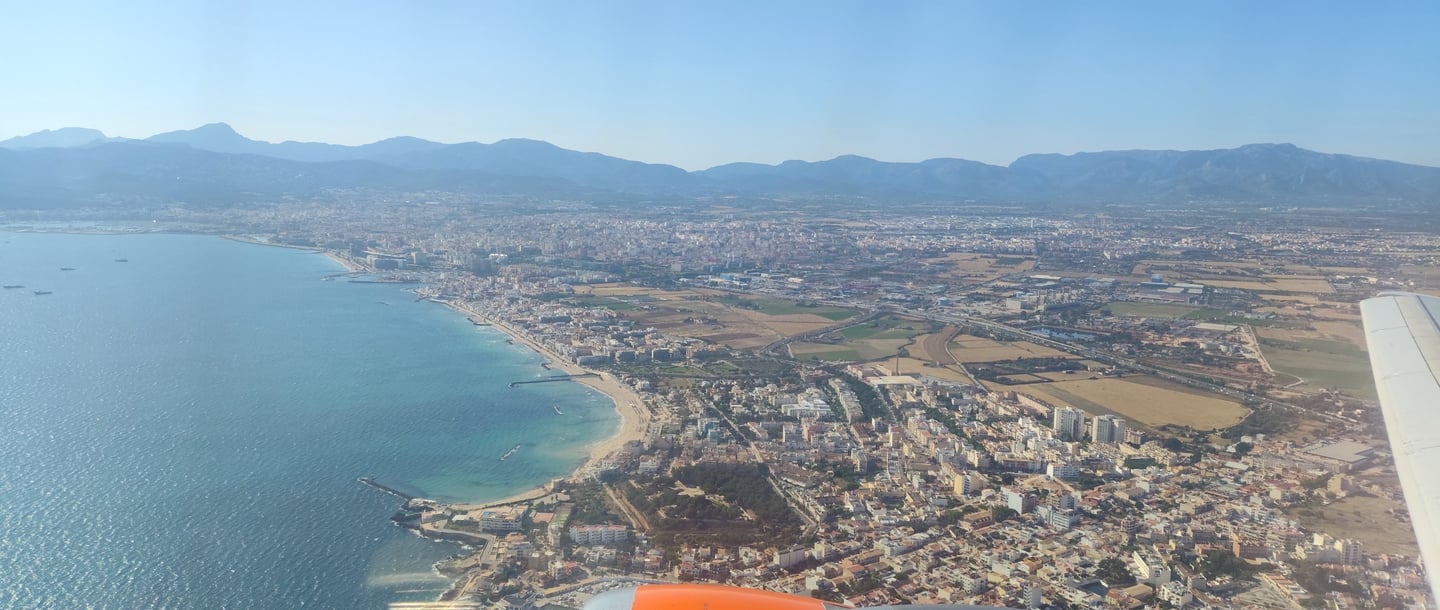Where Is Mallorca or Majorca? Location, Time Zone & Local Tips
Wondering where Mallorca is? Here's a local-style guide to Mallorca's location, time zone, how to get there, and why it's worth visiting.
TRAVEL BLOG
7/15/20253 min read


Where Is Mallorca? Your Easy Guide to Spain's Island Gem ☀️
If you're wondering "Where is Mallorca?" or trying to get your bearings before planning a trip — you're in the right place. Here's everything you need to know about this dreamy island in the Mediterranean, plus answers to other questions people often ask (like "What time is it in Mallorca, Spain?" and more).
🗺️ So, Where Is Mallorca Exactly?
Mallorca (also spelled Majorca) is the largest of the Balearic Islands, located in the western Mediterranean Sea, around 170 km off the eastern coast of mainland Spain. It belongs to Spain and is part of the autonomous community known as the Balearic Islands — alongside Ibiza, Menorca, and Formentera.
✈️ Flying from mainland Spain: Quick hops from Barcelona, Valencia, or Madrid — flights take just 45–60 minutes.
🚢 By ferry: A scenic (and often cheaper) alternative, ferries run from Barcelona, Valencia, and Dénia. Perfect if you're bringing a car.
📍Its capital city, Palma de Mallorca, is located in the southwest. It’s the main gateway to the island and where you'll find the airport, the port, and many of the island’s best cultural and culinary hotspots.
Local tip: Though it's Spanish, Mallorca has a distinct island vibe with strong Catalan roots, rural traditions, and a Mediterranean pace of life that feels a world away from the mainland.
🕰️ What Time Is It in Mallorca, Spain?
Mallorca follows Central European Time (CET) and Central European Summer Time (CEST) — just like most of mainland Spain and much of Europe.
🕒 Standard time (winter): UTC +1 (late October to late March)
🌞 Daylight saving time (summer): UTC +2 (late March to late October)
Time difference examples:
UK: +1 hour
New York (EST): +6 hours
Berlin/Paris: Same time zone
Mallorca observes daylight saving time, so make sure to double-check your time zone if you’re planning travel around March or October.
🌍 Mallorca’s Geography in a Nutshell
Mallorca is surprisingly diverse for its size — roughly 3,600 km², which is just a bit smaller than the US state of Rhode Island.
Here’s a quick breakdown of its main areas:
🏖️ Southwest (Palma, Magaluf, Santa Ponsa): Most urbanised, great for nightlife and international dining.
🏔️ Northwest (Sóller, Deià, Valldemossa): Where you’ll find the Tramuntana Mountains, dramatic cliffs, and charming villages.
🌾 Central plains (Binissalem, Inca): Wine country and traditional Mallorca — slower pace, fewer tourists.
🏝️ East coast (Cala d'Or, Porto Cristo): Calas (coves), family resorts, and quieter beaches.
🌅 North (Alcúdia, Pollensa): Great mix of beach, nature, and relaxed towns.
You can drive across Mallorca in under two hours, making day trips easy. Yet it never feels small thanks to the variety in landscapes.
💬 Do They Speak Spanish in Mallorca?
Yes — and more!
🇪🇸 Spanish (Castellano) is one of the official languages.
🗣️ Catalan is also official and widely used, especially in schools and local signage.
🏝️ Locals speak a dialect called Mallorquín, a variant of Catalan.
In Palma and tourist towns, you'll find plenty of English and German speakers, especially in restaurants, hotels, and shops. But learning a few basic phrases goes a long way in smaller villages.
✈️ How to Get to Mallorca
The quickest and easiest way is by air:
🛫 Palma de Mallorca Airport (PMI) is the third busiest airport in Spain, with direct connections to over 150 European cities.
✈️ Flights from the UK and Germany are frequent, especially from March to October.
🚌 From the airport: You can reach central Palma in 20 minutes by bus or taxi.
Arriving by ferry?
There are several operators with overnight or daytime ferries from:
Barcelona (6–8 hours)
Valencia (7–9 hours)
Dénia (around 5.5 hours)
This is ideal if you're bringing a vehicle or want a slower, scenic route.
🤔 Why Do So Many People Visit Mallorca?
Because it ticks nearly every box for a Mediterranean holiday — and more.
🏖️ Beaches: Over 200 beaches, from family-friendly to remote and hidden
🏔️ Mountains: Epic hiking trails in the Tramuntana range
🏰 Culture: Castles, cathedrals, monasteries, and local festivals
🚴♂️ Outdoor lifestyle: Cycling, rock climbing, sailing, diving, and yoga retreats
🍷 Gastronomy: Local wine, olive oil, sobrasada, fresh seafood, and weekly food markets
Mallorca attracts everyone — cyclists in spring, families in summer, couples in autumn, and nature lovers in winter. It’s an all-year destination, especially appealing outside peak tourist months.
❓FAQs
Is Mallorca part of Spain?
👉 Yes, it’s one of Spain’s Balearic Islands and has local government autonomy.
What’s the time difference in Mallorca?
👉 It’s CET (UTC+1) in winter and CEST (UTC+2) in summer — 1 hour ahead of the UK.
Is Majorca the same as Mallorca?
👉 Yep — “Majorca” is the English spelling; “Mallorca” is the Spanish and local spelling.
Can I drive around the whole island?
👉 Absolutely! It takes around two hours to drive coast to coast, and the roads are well maintained.
When is the best time to visit Mallorca?
👉 Spring (April–June) and autumn (September–October) offer warm weather without the summer crowds.
Looking for more Mallorca tips? Check out:
¡Nos vemos en la isla! 🌴🌞
Get in touch

© 2025 ExplorePalmaDeMallorca.com. All rights reserved.
This site contains affiliate links. I may earn a small commission if you book through them, at no extra cost to you. Thanks for supporting the site!
